Resource management is at the heart of any successful project. By optimizing the tools, people, and processes involved, we can ensure that a project not only meets its goals but also operates efficiently and effectively. This article explores the nuances of resource management in project management, shedding light on its importance, processes, benefits, tools, and techniques.
What is Resource Management?
At its core, resource management is about strategically planning and optimizing the use of resources–whether they’re human, financial, physical, or technological.
A well-defined resource management strategy ensures that the right resources are allocated to the right tasks, preventing wastage and enhancing productivity.
Benefits of Resource Management in Project Management
In the intricate web of project management, resource management shines as a pivotal anchor. Its significance stretches beyond mere allocation; it‘s about orchestrating the very elements that transform a project blueprint into reality.
Here are compelling reasons why resource management is deemed vital in the project management arena:
- Optimizing Performance
Picture resources as instruments in an orchestra. Each instrument, when played at the precise moment, contributes to a harmonious symphony. Efficient resource management ensures every component, whether human talent or material, is harnessed at its peak. This includes aligning a team member’s expertise with corresponding tasks and ensuring resources are never dormant.
- Financial Prudence
Every resource carries a financial implication. From the paychecks of team members to the procurement of tools, there’s a cost at every turn. Judicious resource management ensures these expenditures are curtailed. For example, sidestepping the pitfalls of over-committing resources can avert unexpected overtime expenses.
- Adherence to Schedules
Projects are bound by timelines, and even slight deviations can ripple into cost overruns and missed deadlines. Proficient resource management ensures that indispensable assets are in place when they’re most needed, eliminating bottlenecks.
- Boosting Team Spirit
Human resources thrive on motivation. Efficient management ensures workloads are balanced and tools are accessible, fostering a conducive working ambiance. A spirited team is invariably a high-performing one.
- Forward-Looking Insights
Superior resource management transcends the immediacy of now; it’s about forecasting the horizon. Scrutinizing past resource trends and deployment patterns empowers managers with foresight, enabling them to preemptively address resource constraints.
- Elevating Stakeholder Trust
A project‘s lifeline hinges on its stakeholders. Diligent resource management in project management guarantees that projects resonate with the triad of timeliness, scope, and budget. Meeting these pivotal parameters not only gratifies stakeholders but also augments the organization’s stature, paving the way for future endeavors.
Project Resource Management Process
Every journey has a roadmap, and in the realm of resource management, understanding the process is that crucial map. By meticulously navigating through each phase, project managers can ensure resources are utilized to their fullest potential.
The resource management process isn’t just about assigning resources. It’s a holistic approach that involves planning, monitoring, and adjusting resources in alignment with project goals.
Steps in the Project Resource Management Process
Each phase of this process plays a pivotal role:
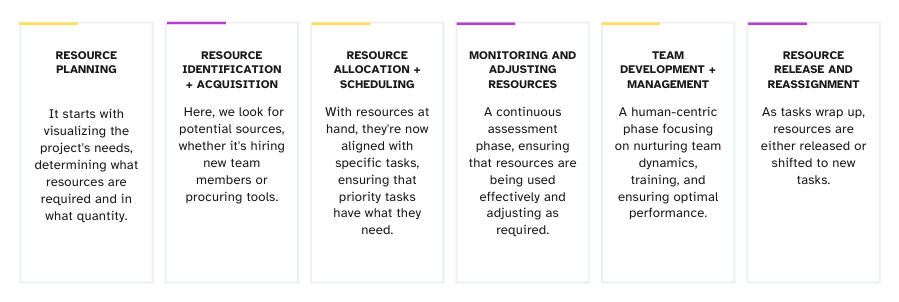
1. Resource Planning
It starts with visualizing the project’s needs, determining what resources are required and in what quantity.
2. Resource Identification and Acquisition
This is the hunting phase. Here, we look for potential sources, whether it’s hiring new team members or procuring tools.
3. Resource Allocation and Scheduling
With resources at hand, they’re now aligned with specific tasks, ensuring that priority tasks have what they need.
4. Monitoring and Adjusting Resources
A continuous assessment phase, ensuring that resources are being used effectively and adjusting as required.
5. Team Development and Management
A human-centric phase focusing on nurturing team dynamics, training, and ensuring optimal performance.
6. Resource Release and Reassignment
As tasks wrap up, resources are either released or shifted to new tasks.
It’s essential to constantly refine this process. Regular feedback, lessons learned, and industry best practices should be integrated to enhance efficiency.
Types of Resources in Project Management
Each project is unique but relies on a combination of resources. Understanding these types of resources in project management is crucial for their effective management.

Human Resources: This pertains to the team–the backbone of any project. It’s essential to ensure the right people with the right skills are on the job.
Material Resources: These are the tangible assets, whether it’s machinery in a construction project or computers in an IT venture.
Financial Resources: Every project operates within a budget. Efficiently managing this budget is paramount.
Intangible Resources: Often overlooked, these are assets like software licenses or even brand reputation which play an indirect role in a project’s success.
Resource Management Reports and Dashboards
Just like a captain relies on a compass, project managers depend on reports and dashboards to navigate the vast sea of resource management.
The saying “what gets measured gets managed” holds true here. By consistently analyzing reports, managers can glean insights into how resources are utilized, spot inefficiencies, and forecast future needs. This proactive approach can be the difference between a project’s success and failure.
Types of Reports
From understanding how each resource is utilized to mapping out allocation patterns, different reports serve different purposes:
- Utilization Reports
They offer insights into the efficiency of resource usage. Overutilization can lead to burnout, while underutilization could hint at potential resource wastage.

- Allocation Reports
By detailing which tasks resources are assigned to, these reports help ensure that there’s no overlap or missed tasks.
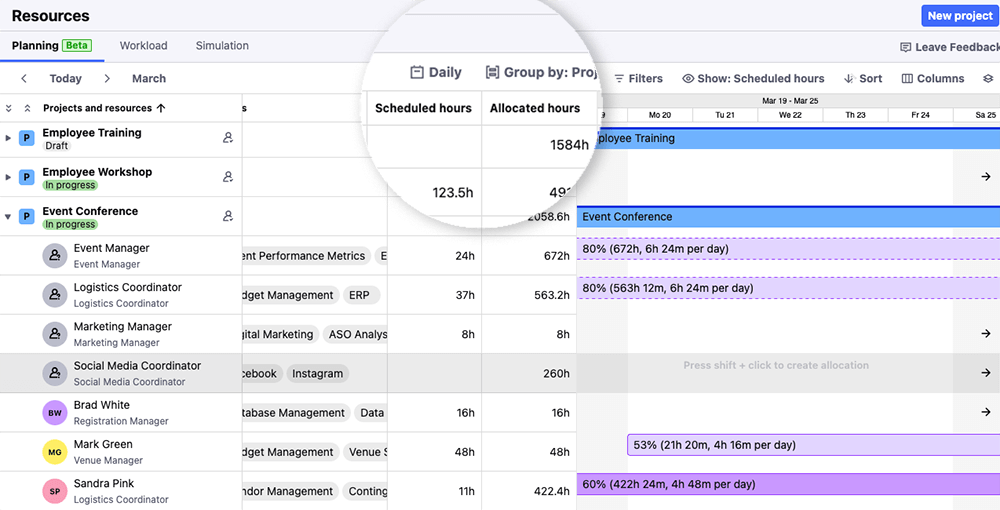
- Forecasting Reports
Predictive in nature, these reports use current trends to anticipate future resource requirements.
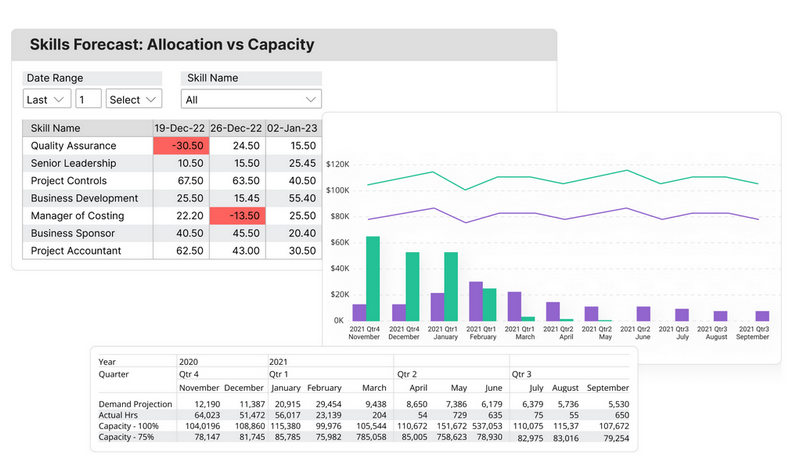
Designing Effective Dashboards
In today’s digital age, dashboards are the visual representation of data. An effectively designed dashboard allows managers to quickly grasp the resource situation, aiding faster decision-making. Think of it as a car’s dashboard; you want the most crucial information to be visible at a glance.
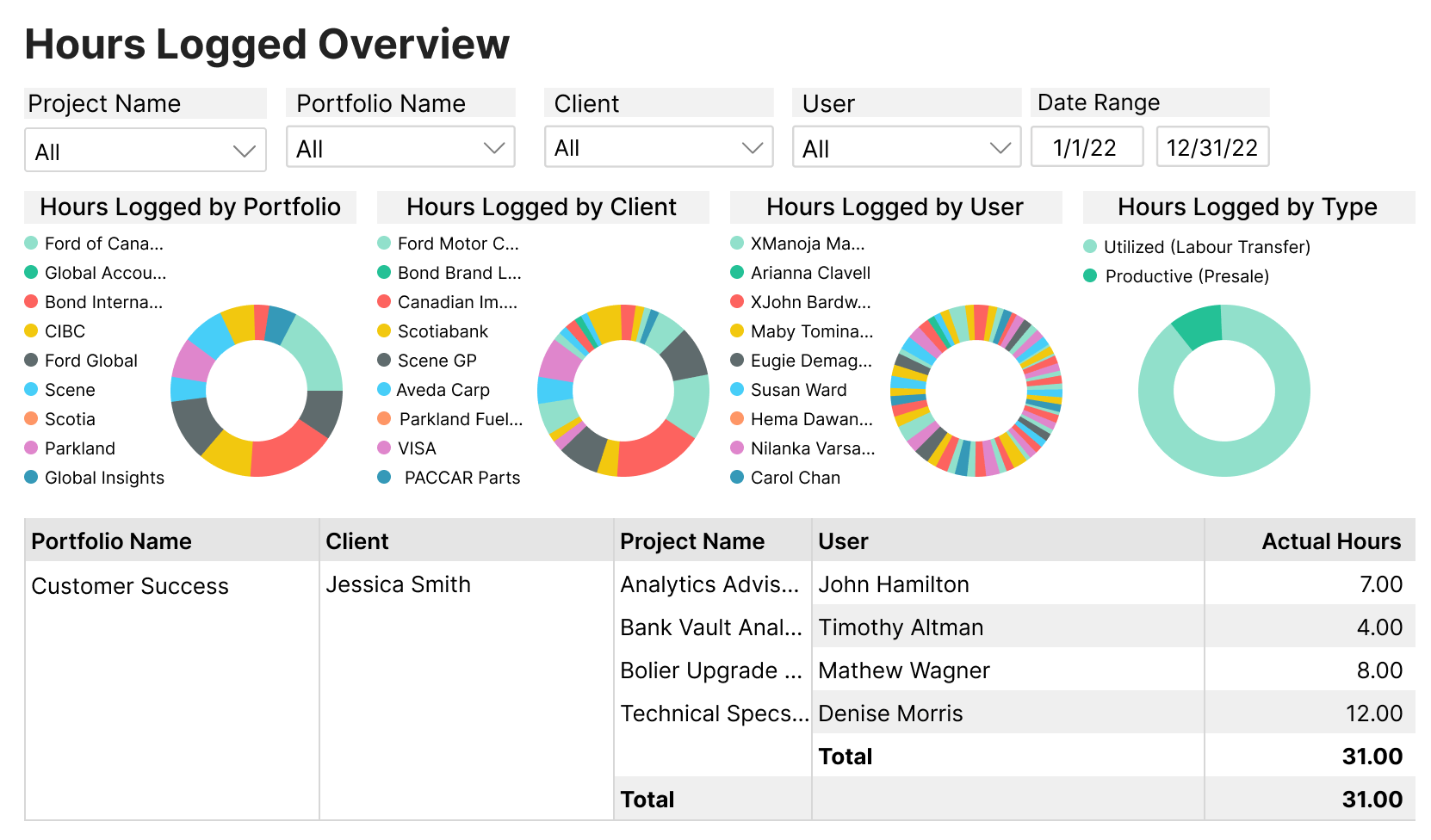
Key Performance Indicators (KPIs) for Resource Management
KPIs are the metrics that matter. In resource management, this could include the utilization rate, resource availability, and efficiency in project delivery. Regularly tracking these KPIs ensures the project stays on the path to success.
Resource Manager in Project Resource Management
Behind every successful project is a dedicated Resource Manager ensuring the gears of resource management run smoothly.
Role and Responsibilities
The Resource Manager’s role isn’t just about allocating resources. It’s a blend of strategic planning, coordination, and problem-solving. They ensure resources align with project goals, solve allocation conflicts, and ensure that the team is motivated and productive.
Skills and Qualities of an Effective Resource Manager
A blend of soft and hard skills makes a Resource Manager effective:
Excellent communication: It’s crucial in coordinating between teams and stakeholders.
Analytical thinking: With resources often being limited, optimal allocation requires meticulous analysis.
Proactive problem-solving: Anticipating challenges and having solutions ready ensures smooth project execution.
The Resource Manager acts as a bridge, ensuring resources, whether human or material, align perfectly with project objectives. It’s this alignment that often dictates the pace and quality of project delivery.
In the complex maze of projects, resource conflicts are inevitable. It falls upon the Resource Manager to swiftly address and resolve these, ensuring project momentum isn’t lost.
Project Resource Plan Template
Consider the template as a blueprint. Just as architects use blueprints to visualize the final structure, project managers use resource plan templates to envision how resources will play out throughout the project.
In the realm of project management, crafting a cohesive project resource plan is akin to plotting a course on a navigation map. This plan serves as a guide, providing a clear picture of the resources needed and when they are required. Central to this is a well-structured template. Let‘s dive into the intricacies of such a template, its importance, and how it can be tailored to diverse project requirements.
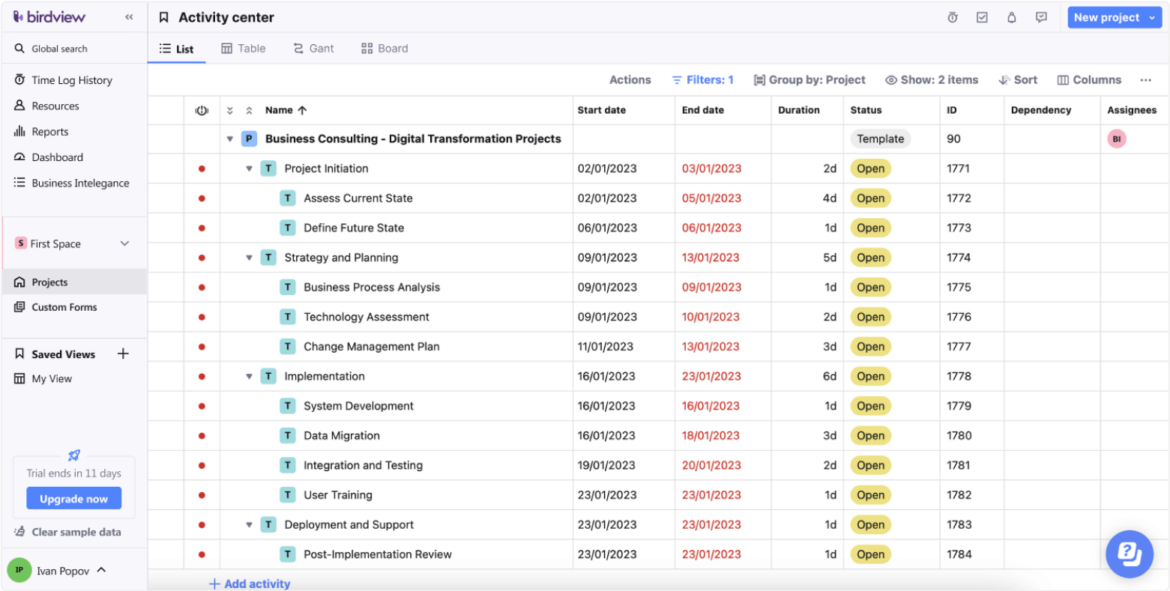
Importance of a Structured Template
A template isn‘t just about filling in the blanks; it’s a structured tool that streamlines the resource planning process.
- Consistency: A standardized template ensures a consistent approach across multiple projects, fostering familiarity and efficiency within teams.
- Efficiency: With a structured format, managers can quickly identify gaps, forecast needs, and allocate resources without missing key details.
- Clarity: Clear categorization and organization in a template present a bird’s-eye view of resource allocation, facilitating informed decision-making.
- Coordination: A well-documented resource plan facilitates better communication among stakeholders, ensuring everyone is on the same page.
Key Components of the Template
A comprehensive template is often built around certain crucial components:
- Resource Identification: Clearly list and categorize resources, be it human, material, or financial.
- Time Allocation: Specify the duration for which each resource is needed – start and end dates.
- Roles & Responsibilities: For human resources, define roles, responsibilities, and the reporting structure.
- Quantity: Enumerate the amount of each resource required, from team members to equipment.
- Cost Estimation: Provide a breakdown of costs associated with each resource.
- Availability Schedule: Highlight when specific resources are available and any constraints.
- Dependencies: Identify any interdependence between resources or tasks.
- Risk Assessment: Document potential risks associated with resource allocation and mitigation strategies.
Steps to Create a Comprehensive Resource Plan
Creating an actionable resource plan demands a methodical approach:
- Assess Scope & Objectives: Understand the breadth of the project and its goals.
- List Resources: Enumerate all the resources you anticipate needing.
- Estimate Quantities & Duration: Determine how much of each resource is required and for how long.
- Allocate Tasks: For human resources, define roles and assign tasks.
- Document Dependencies: Identify and document any interlinked tasks or resources.
- Establish a Monitoring Mechanism: Integrate a tracking system to monitor resource utilization against the plan.
- Feedback Loop: Ensure there‘s a mechanism for teams to provide feedback on resource availability or constraints.
Adapting the Template to Different Project Needs
While a template provides structure, it‘s not set in stone. Different projects have unique needs, and your template should be malleable:
- Scale Appropriately. A large-scale construction project will differ vastly from a small software development project. Adjust your template’s granularity accordingly.
- Industry Nuances. Different industries have varying terminologies, standards, and requirements. Ensure your template speaks the language of the specific industry. Using the Depositphotos API Suite enhances your content by seamlessly integrating industry-specific visuals, ensuring your templates align with the right language and imagery.
- Iterate and Evolve. As you gain more insights from past projects, periodically refine your template.
- Customizable Sections: Leave room for adding or removing sections as per the project’s unique requirements.
In essence, a Project Resource Plan Template serves as both a roadmap and a reflection tool. It directs project managers on resource allocation while also providing a platform to learn, iterate, and perfect the resource management process.
Techniques for Resource Management
In the dynamic landscape of project management, the art of efficiently managing resources often boils down to employing the right techniques. Each technique provides a unique approach to navigating the complexities of resource allocation, ensuring projects remain on track and within scope. Here’s a deep dive into some of the most impactful techniques in resource management:
Resource Leveling
Resource leveling is primarily focused on balancing the demand for resources with the available supply. It’s a technique used when specific resources are over-allocated, meaning they have more work than they can realistically handle.
- Process: This technique involves redistributing the work from periods of over-allocation to times when the same resources are under-allocated.
- Benefits: It helps in preventing resource burnout and ensures a continuous workflow, avoiding periods of inactivity.
- Application: Commonly used in scenarios where keeping a consistent team is crucial for project success or when specific resources (like equipment or experts) are limited and cannot be overworked.
Resource Smoothing
Resource smoothing is a technique used when the time constraint is flexible, but resource availability is constrained. Unlike leveling, smoothing does not change the project completion time; it only adjusts resource allocation.
- Process: Tasks are rescheduled within their float times (the time tasks can be delayed without affecting subsequent tasks) to make use of available resources without overloading them.
- Benefits: It optimizes the allocation of available resources without altering the project‘s end date.
- Application: Useful in projects where resource availability is strictly constrained, and there’s a need to align tasks within a set timeframe without stretching resources.
Time-boxing & Sprint Planning (Agile)
Born out of Agile methodologies, especially Scrum, time-boxing is about allocating a fixed duration for activities, ensuring they are completed within that time frame, known as ‘sprints’.
- Process: Activities are grouped into ‘sprints’, which are fixed-duration cycles, commonly two to four weeks long. The work to be done is defined at the beginning of the sprint and is not changed during the sprint.
- Benefits: Promotes focus, reduces scope creep, and encourages feedback at the end of each sprint, allowing for better resource planning in subsequent cycles.
- Application: Particularly beneficial in software development projects or any project following the Agile framework.
Prioritization and Critical Path Method (CPM)
The Critical Path Method serves as a sequential approach to project timeline management, pinpointing the extended chain of activities leading to project culmination.
- Process: Activities are organized in order, considering their interdependencies. The sequence with the most extended span becomes the critical path, indicating the minimum duration required to wrap up the project.
- Advantages: Underscores tasks of utmost importance affecting the final project date, enabling optimal resource dedication to these pivotal activities.
- Usage: Common in infrastructure projects, IT solutions development, and projects that boast a multitude of interrelated tasks.
Eisenhower Matrix for Task Prioritization
Often dubbed the Urgent-Important Matrix, the Eisenhower Matrix stands as a tool designed for decision-making, aiding in arranging tasks by their immediacy and significance.
- Process: Tasks are charted on a four-square matrix, with the axes denoted as “urgent” and “important”. The quadrants formed are:
- Urgent and important
- Not urgent but important
- Urgent but not important
- Neither urgent nor important
- Advantages: Offers a transparent visual framework indicating primary resource allocation, ensuring immediate attention to pivotal activities.
- Usage: Perfect for projects housing numerous tasks with diverse significance levels, aiding managers in resource distribution.
Work Breakdown Chart (WBC)
The WBC is a tiered decomposition of the cumulative workload assigned to the project unit.
- Process: The project is broken down into smaller components, ensuring each part is manageable and can be assigned to the appropriate resources.
- Benefits: It allows for clearer visualization of the work, easier assignment of responsibilities, and better tracking of project progress.
- Application: Commonly used in projects of all sizes across industries to ensure a clear roadmap of tasks and resource allocation.
Resource Histograms
These graphical representations demonstrate the duration a resource is slated to be engaged across different periods.
- Process: While the horizontal axis displays time, the vertical axis showcases the resource’s capacity or requirement.
- Advantages: Provides managers with the capability to detect either excessive or inadequate resource allocation instantaneously.
- Usage: Apt for projects of varied sizes, offering a snapshot of resource engagement over a span.
Monte Carlo Simulation
A probabilistic method enabling the evaluation of potential risks associated with a particular project schedule.
- Process: Through the creation of diverse scenarios, project overseers can gauge potential results and their corresponding probabilities.
- Advantages: Facilitates the recognition of allocation risks and projects the possibility of adhering to the timeline.
- Usage: Especially relevant for expansive projects with notable variables in resource distribution and task timeframe.
Heuristic Allocation
It’s the process of assigning resources based on certain guiding rules or ‘heuristics’ rather than detailed analysis.
- Process: Based on experience or specific project needs, managers use rules-of-thumb to allocate resources.
- Benefits: Speeds up decision-making in resource allocation, especially when detailed analysis is time-consuming or not feasible.
- Application: Useful in projects where time is of the essence or where empirical decisions have proven effective in the past.
Resource Aggregation
It is the accumulation of all resource requirements in a particular time period, often used in conjunction with other techniques like CPM.
- Process: All resource requirements are added up for each time period, usually represented graphically.
- Benefits: Provides a snapshot of total resource requirements over time, allowing for adjustments as needed.
- Application: Suitable for projects that require periodic assessments of resource needs.
Including these techniques provides a comprehensive perspective on resource management, allowing project managers to have a versatile toolkit to tackle various challenges that arise during the project lifecycle.
Resource Management Tools
Resource management is a multifaceted domain that requires an array of resource management tools to be handled effectively. The digital age has ushered in a plethora of platforms and software to simplify this task, making it more efficient and data-driven. From planning and allocating resources to tracking time and collaborating with teams, here’s a comprehensive look at the different tools available for resource management.
Resource Management Software & Platforms
These are comprehensive solutions designed specifically to aid in planning, allocating, and monitoring resources.
Functionality: These platforms allow managers to visualize resource allocation, manage scheduling, predict resource needs, and even integrate with other project management tools.
Example: Birdview PSA
Birdview PSA (Professional Services Automation) stands out as a comprehensive solution tailored for service-oriented businesses.
Functionality: It offers an array of features from project management, resource planning, time tracking to billing. Its resource management capabilities are particularly noteworthy, offering deep insights into resource allocation, availability, and forecasting.
Application: For organizations juggling multiple projects simultaneously, Birdview PSA provides a unified view of all resources, making it simpler to allocate, re-allocate, and optimize based on evolving project needs.
Project Management Tools
These tools are often the hub of any project, providing a central platform for task allocation, timeline tracking, and stakeholder communication.
Functionality: Project management tools come with features like Gantt charts, task dependencies, and progress tracking, which aid in ensuring resources are utilized in alignment with project timelines and objectives.
Example:
Asana: Known for its intuitive interface, Asana allows teams to break projects down into tasks, assign them to members, and track progress. Its resource management capabilities enable project managers to allocate tasks effectively based on resource availability and workload.
Trello: With a card-based system, Trello is excellent for visualizing task progression. It‘s easy to integrate with resource allocation plugins and tools, ensuring seamless resource management within the project framework.
Time-tracking Tools
Time, being one of the most vital resources, necessitates precise tracking, especially in projects where billing is hourly or to optimize workforce productivity.
Functionality: These tools help in monitoring the hours dedicated to tasks, making it easier to gauge productivity, analyze time allocation, and even invoice clients.
Example:
Toggl: A user-friendly tool that provides real-time tracking and detailed reports, enabling teams and freelancers to monitor how they spend their work hours.
Harvest: Beyond time tracking, it integrates invoicing and expense tracking, making it a comprehensive solution for freelancers and agencies.
Collaboration & Communication Tools
Effective resource management isn’t just about tools and timelines; it’s about people. Communication forms the backbone of any project, ensuring that resources are aligned with objectives.
Functionality: These platforms facilitate seamless communication between teams, helping them stay informed, collaborate on tasks, and share feedback.
Example:
Slack: More than just a messaging app, Slack offers integrations with numerous project and resource management tools, making resource-related communication efficient and centralized.
Teams: Microsoft’s answer to collaborative communication, Teams not only offers chat and video conferencing but also integrates deeply with Office 365 tools.
Resource Calendars
A resource calendar provides a visual representation of resource availability, allocations, and schedules, ensuring that there’s no over-commitment or under-utilization.
Functionality: These calendars provide an at-a-glance view of when and where resources are deployed, highlighting potential conflicts or gaps.
Example: Many resource management platforms, like Microsoft Project or Monday.com, come with integrated calendar views. Standalone options, like Google Calendar, can also be customized for this purpose.
Capacity Planning Tools
Capacity planning is about ensuring that you have enough resources to meet project demands without overstretching or underutilizing.
Functionality: These tools analyze the maximum capacity of your resources and help in forecasting and optimizing allocation based on project needs.
Example: Platforms like Smartsheet and Resource Guru are designed to provide insights into resource capacity, aiding managers in making informed allocation decisions.
In the grand scheme of project management, tools like Asana, Trello, and Birdview PSA don’t just facilitate task management but play a pivotal role in ensuring resources are used judiciously and effectively. This symbiotic relationship between project management and resource management is what often steers projects toward success.
Challenges in Resource Management
In the intricate world of project management, managing resources is a pivotal component. Yet, like all disciplines, resource management faces its own set of challenges, which when unaddressed, can disrupt the project‘s flow. Diving deeper, let’s dissect these challenges and explore real-world examples to better understand their implications.
Resource Conflicts and Over-allocation
The simultaneous running of multiple projects can sometimes lead to resources being double-booked or stretched thin.
Resource Burnout: Overburdening resources, especially human ones, can reduce output quality and increase the risk of burnout.
Example: Consider a scenario in a software company where a developer, Jane, is allocated to two projects simultaneously. While initially, she manages both, as deadlines loom, she’s stretched thin, leading to potential oversights in her code and increased stress.
Project Delays: Competing for the same resources can cause project delays.
Example: A construction firm working on two sites may have only one crane available. If both sites need it simultaneously, one site inevitably faces delays.
Forecasting Resource Needs Accurately
Accurately determining future resource needs is challenging due to the fluid nature of projects.
Varying Project Dynamics: Projects can evolve, making initial forecasts inaccurate.
Example: An event planning company might forecast needing five event managers for a season. However, a sudden surge in bookings might necessitate hiring more managers.
Historical Data Limitations: Past projects can provide insights, but every project is unique.
Adapting to Changing Project Requirements
In a dynamic environment, project requirements can shift swiftly.
Re-allocation Challenges: Adapting means reallocating resources, and disrupting workflows.
Example: In a software project, a client might request the addition of a new feature halfway. This requires reallocating developers and testers, potentially disrupting the project timeline.
Resource Skill Mismatch: New requirements might need skills that aren‘t immediately available.
According to the Project Management Institute (PMI), “Changing requirements is one of the top challenges faced by 39% of project managers.”
Communicating Resource Changes to Stakeholders
Being transparent about resource changes without overwhelming stakeholders is crucial.
Managing Expectations: Any change in allocation affects outcomes, necessitating clear communication.
Example: If a key team member falls ill and a project is delayed, stakeholders must be informed promptly, explaining the delay and the steps taken to mitigate it.
Transparency Quandaries: Overloading stakeholders with too much information can be counterproductive.
Maintaining Resource Skills and Training
Challenge: With the rapid pace of technological advancement, skills can become obsolete quickly. This necessitates continuous training and upskilling to ensure resources are equipped for the tasks at hand.
Example: A company using older software may find that as they upgrade, their employees lack the skills to use the new system efficiently.
Balancing Cost Constraints with Quality
Challenge: There’s a constant tug-of-war between maintaining project quality and adhering to budgetary constraints. Cutting corners can reduce costs in the short term but can compromise the quality of the end product or service.
Example: A construction firm might be tempted to use lower-quality materials to stay within budget, but this could lead to future maintenance issues or safety concerns.
Global and Remote Team Coordination
Challenge: With the rise of remote work and global teams, coordinating across time zones and cultures introduces its own set of resource management challenges.
Example: If your digital marketing agency in San Diego and a development team in Bangalore might struggle with communication due to time zone differences, potentially causing project delays.
Adapting to Regulatory and Compliance Changes
Challenge: Especially in sectors like finance, healthcare, or energy, regulatory and compliance standards can shift, demanding adaptability in resource allocation.
Example: If new data protection regulations are introduced, an IT company may need to reallocate resources swiftly to ensure compliance, possibly drawing them away from other important tasks.
Mitigating Resource Risks
Challenge: Unexpected events, from equipment failures to global pandemics, can severely disrupt resource availability.
Example: The COVID-19 pandemic forced many companies to shift to remote work abruptly, introducing challenges in coordination, communication, and technology infrastructure.
Managing Cultural and Interpersonal Dynamics
Challenge: In diverse teams, cultural differences and interpersonal dynamics can affect collaboration and resource allocation.
Example: A multicultural team might face challenges in communication styles, work ethics, and even holidays, all of which need to be accounted for in resource planning.
Recognizing these challenges is the first step. By proactively addressing them, organizations can fortify their resource management strategies and navigate the complexities more effectively.
Conclusion
Resource management in project management, with its myriad processes, techniques, tools, benefits, and challenges, stands as a foundational pillar in the domain of project management. As we reflect upon our exploration, a few key takeaways emerge.
Resource management transcends mere allocation; it is the art and science of maximizing efficiency and value. Proper resource management ensures optimized utilization of resources, from human capital to technological assets, resulting in timely project delivery, reduced overheads, and increased stakeholder satisfaction. Without robust resource management, projects can falter, facing delays, cost overruns, and potential failures.
Example: Just as a maestro ensures every instrument in an orchestra plays in harmony, a project manager uses resource management in project management to ensure every resource contributes to a project‘s success in a coordinated fashion.
The dynamic nature of projects and the ever-evolving business landscape demands that professionals in resource management remain agile. Continuous learning, adaptation, and a proactive approach to challenges are essential.
Resource management tools and techniques will evolve, project needs will shift, and unforeseen challenges will emerge. By embracing a mindset of continuous improvement and staying abreast of industry best practices, project managers and teams can navigate these intricacies with confidence.
As Charles Darwin famously noted, “It is not the strongest of the species that survives, nor the most intelligent; it is the one most adaptable to change.”
In the world of project management, this adaptability, combined with a deep understanding of resource management tools and principles, paves the way to sustained success. As we look ahead, it’s clear that effective resource management in project management will remain a cornerstone for project managers and teams globally.



